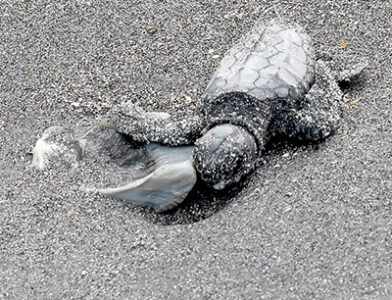Environment
DNA samples show first-time nesters among area sea turtles

Among the new visitors to Pawleys Island this summer are sea turtles.
Mary Schneider, who oversees the S.C. United Turtle Enthusiasts volunteers on the island, said DNA testing on eggs showed that several turtles had never nested on the island before.
“We call them new recruits,” Schneider said. “You feel good when you see it’s a first-time nester.”
SCUTE started doing DNA testing on one egg from every nest more than a decade ago. The research showed that sea turtles often return to the same area to nest.
Schneider believes that some of the new turtles nesting on the island this year could be hatchlings from nests that SCUTE protected decades ago.
DeBordieu has had 21 nests, including one from a green turtle.
“It’s slow from Winyah Bay north,” said Betsy Brabson, who leads the SCUTE volunteers for DeBordieu and Hobcaw Beach. “The southern part of the state is having a great year.”
DeBordieu had its first nest inventory on Saturday. Thirteen hatchlings were found alive and released.
Seventy-seven percent of the eggs hatched.
“Anything over 70 continues the proliferation of the species,” Brabson said.
It was the first nest to hatch in the state north of Cape Romain. It also hatched in 60 days, while the state average has been 66 days.
“We’re not sure why this nest [hatched], when there are others that were laid [earlier] when it was cooler. Everything has to do with temperature with reptiles,” Brabson said. “We were excited. It took us by surprise.”
Litchfield By The Sea, South Litchfield and North Litchfield have combined for 16 nests.
South Litchfield completed a renourishment project last year. Rick Scott, who leads the Litchfield Beach SCUTE volunteers, said one turtle recently came ashore and dug a hole a few feet deep and left without dropping her eggs.
When Scott examined the hole, he found the sand to be as hard as concrete.
“It’s really a challenge on that renourished beach,” Scott added.
There have been 5,954 nests along the South Carolina coast this year. Nearly all have been loggerheads.
There have also been 9,811 false crawls.
Eleven green turtles have nested in the state, three of them at Huntington Beach State Park, which also has 13 loggerhead nests.
There has also been two nests laid by a Kemp’s Ridley, the rarest and most endangered turtle species in the world, on Hilton Head Island and one on Botany Bay Island.
Last year North Myrtle Beach had the only Kemp’s Ridley nest in the state.
The first nest of the season was on May 2 on Cape Island, which leads the state with 1,430 nests,
The other sites with the most nests are: Lighthouse Island 1,201, South Island 450, Kiawah Island 397, and Hilton Head Island, 315.
Nesting season is winding down so Schneider doesn’t expect there to be too many more nests.
“I’m pleased with 25,” she said. “We’re having a good season and we’re happy.”
The first hatch and inventory on the island should be next week.
Brabson’s volunteers are frustrated because there’s not enough nests to get the training they need to get certified by the state Department of Natural Resources.
“A lot of our volunteers haven’t even had nests,” she said. “They’re hoping for next year to be a bumper year.”
Sea turtles only nest every two or three years.
Last year there were 8,003 nests in South Carolina, an increase of 2,359 over 2021. Those nests produced 739,310 eggs. In 2021, 523,423 eggs were found.
Eighty-six nests were recorded in DeBordieu/Hobcaw by SCUTE volunteers, the third most since monitoring began.
Pawleys Island had 30 nests. It was only the third time in 28 years that the island has seen 30 or more nests.
North and South Litchfield set a record with 33 nests.
To keep track of nesting and inventory activities in Georgetown and Horry counties, visit SCUTE’s page on Facebook.




